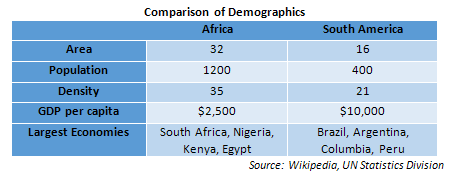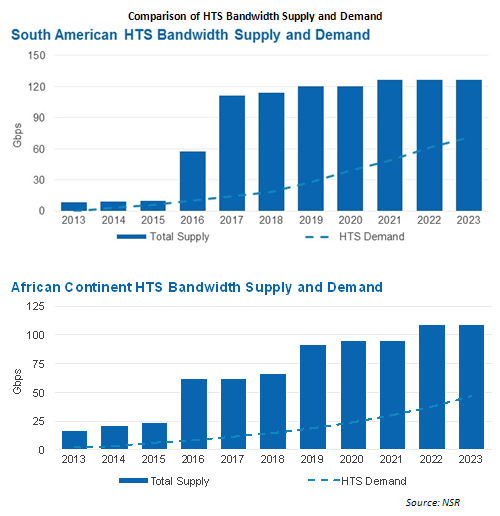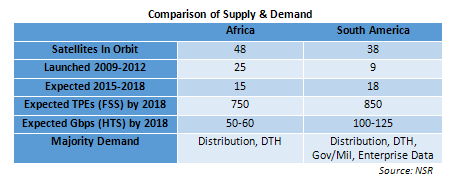Will Latin
America Repeat Africa’s Oversupply
Situation?
Oct 5th, 2014 by
Prashant
Butani, NSR
Why Compare
The Two?
At
first this seems like an unusual combination
of continents to compare and contrast.
Africa is about three times the population
of South America, twice the area and more
than one and half times more dense in terms
of people per square kilometre. South
America on the other hand, has a GDP per
capita that is almost four times that of the
African continent. Yet, both regions have
contributed
one country each
to the BRICS viz. Brazil and South Africa.
Both continents have close ties to their
northern counterparts (Europe and North
America) in terms of language, video
distribution platforms and connectivity.
Both continents have also
played host to
the FIFA World Cup,
an event known to attract viewers – and
hence consumption of satellite capacity –
from across the globe. However, what makes
the comparison interesting is that while
Africa has seen almost all satellite
operators launch capacity for the region
over
the last 5 years;
for South America that phase of a “supply
boom” is expected to play out over
the next
half decade.
A fact that warrants the question above –
will this amount to over capacity, excessive
competition and eventually, falling prices
(read lower revenues & margins)?

Are There
Trends Behind The Launches?
For
starters, Africa has about 48 satellites in
service currently carrying C-band and/or
Ku-band capacity in the 50 West to 95 East
orbital arc that allows fairly decent look
angles into the continent. For South
America, albeit a smaller region, that
number for its orbital arc is about 38
satellites in service. Now that may suggest
nothing extraordinary but of those numbers,
between 2009 and 2012, a span of only 4
years, there were about
25 launches over
Africa whereas the number for South America
was merely 9 satellites.
Clearly, the operators had decided that
there was a gap left by fibre in the African
market that only satellite could help fill.
What they perhaps had not anticipated was
that the near monopoly in the video
distribution markets in Africa would not
change drastically and that VSAT operators
would eventually consolidate as fibre became
more prevalent. All this while, more and
more operators laid their claim to
the
promise of Africa
thus leading to increased competition and
eventually lower fill rates and falling
prices.

South America, on the
other hand, becomes the region in focus if
you now look at how much capacity is coming
online in the next 3-5 years. There are
about 18 satellites announced for South
America carrying either C / Ku or HTS
capacity whereas the figure for Africa is
about 15. In terms of TPEs of C, Ku and
Ka-band capacity, South America is expected
to add about 850 TPEs by 2018 as compared to
only 750 for Africa by the same period. The
difference becomes extremely evident when
one looks at only HTS capacity, measured in
Gbps. Here, the figure for
South
America is at 100-125 Gbps by 2018 as
compared to only 50-60 Gbps for Africa.
Now this figure does include Brazil’s SGDC-1
which is not entirely a commercial payload
but that does not rule out its role in
Digital Divide programs. So despite all the
“unconnected” markets that Africa offers
compared to a more robust fibre network for
South America, effectively the HTS capacity
coming online for data services is just
under half!
What Does
This Discrepancy Mean?
For
starters, one must take into account that
South America is benefiting from the lessons
learned on HTS systems in other parts of the
world, namely North America and Europe. The
applications are largely data driven and
even there, more suitable for consumer
broadband. As an application, that has
demanded a
higher purchasing
power and disposable income
from the population that lives beyond the
reach of terrestrial solutions. At $10,000
GDP per capita for South America versus
$2,500 for Africa, it now begins to seem
obvious why there are fewer HTS birds for
the latter. In addition, the geo-political
climate in South America is one of a large
dominant economy (Brazil) versus 2-3 growing
economies (South Africa, Kenya, Nigeria)
that make the former region perhaps
easier to
navigate
for those launching HTS-based services.
Also, the video markets in Africa remain
somewhat closed with MultiChoice still
maintaining incumbent status and smaller
players yet to gain significant ground.
South America offers a
much more vibrant
DTH market
and with penetration rates of digital TV
still low the potential headroom is still
attractive. All of these factors point
towards there being more easily addressable
demand, and hence more supply, for the South
American market.
Does More
Supply Mean Excess Supply?
This, then becomes the multi-million dollar
question as to whether South America will
suffer the same fate as Africa in the longer
term with excess supply. The
supply over
Africa has been, and will be for some time,
largely FSS
i.e. traditional wide beam C, Ku and
Ka-band. This is suited for both video and
data markets and while it typically means
higher cost per bit for data, there have
been players like Yahsat and Avanti that
have brought arguably cheaper Ka-band
capacity into the African data market.
Despite this, fill rates over Africa remain
low (in the sub-55% range) and are expected
to continue this way until supply additions
slow down. Will South America suffer a
similar fate?

The answer is two-pronged and
varies depending on whether it is video or
data markets one addresses. For video
(effectively FSS supply and demand) South
America seems to be offering enough
opportunities between now and
the 2016
Brazil Olympics.
Even after that inflexion point, there are
enough countries with
Analog
Switch-Over plans
to keep fill rates ticking upwards for the
region on the video side. For data, however,
the answer is not as straightforward. Yes,
there seems to be a
consumer
broadband
market for the taking in the suburban and
remote areas of Brazil and few other
countries. There are even quite a few
USO-driven Digital Divide
programs run by the Government that would be
happy to run on HTS capacity that lowers the
cost per bit. However, and other developed
markets have shown, that Government-backed
rural broadband programs don’t always work
according to schedule. In addition, if there
are too many HTS systems lowering the cost
per bit, then it becomes a problem of plenty
and this is where NSR believes that there
could be over supply in the near term. A
corollary to lowering the cost per bit is,
of course,
opening new
applications and markets
like mobility (aeronautical, maritime or
land-mobile) and video contribution that
could foster demand and stabilize fill rates
in the longer term.
Bottom Line
Yes, if one only looks at launches and
amount of FSS and HTS capacity coming online
it does seem that South America is going
down the same path as Africa. However,
it
may not be as slippery a slope,
because the situation in Africa was
different. Africa saw FSS oversupply as a
result of fibre expansion and geo-political
challenges in markets that had satellite
demand. South America is ahead of Africa
with respect to fibre. Not to say that it
isn’t expanding, but growth in the former is
more evolutionary as major fibre routes
(both land and submarine) were deployed
years ago and the market has absorbed these.
The only caution, that NSR advises operators
in South America actually goes back to
Finance 101 –
Compound
opportunity in the present and Discount
projections of the future.